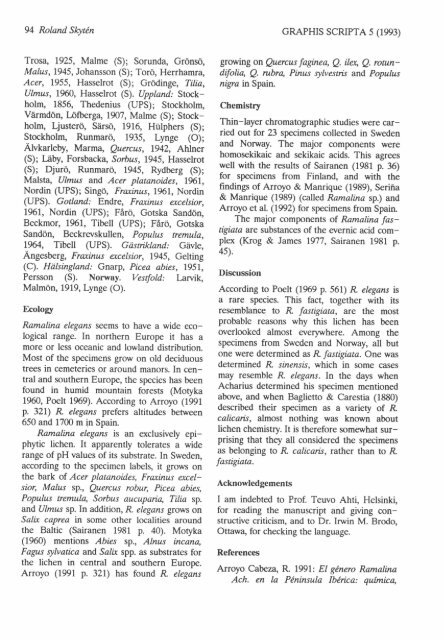GRAPHIS SCNIPTA - Universitetet i Oslo
GRAPHIS SCNIPTA - Universitetet i Oslo
GRAPHIS SCNIPTA - Universitetet i Oslo
You also want an ePaper? Increase the reach of your titles
YUMPU automatically turns print PDFs into web optimized ePapers that Google loves.
94 Roland Slqtin<br />
GRAPHTS SCRTPTA 5 (1ee3)<br />
Trosa, L925, Malme (S); Sorunda, Gr6nso,<br />
Malus,1945, Johansson (S); Toro, Herrhamra,<br />
Acer, 1955, Hasselrot (S); Greidinge, Tili"a,<br />
Ulmus, L960, Hasselrot (S). Uppland: Stockholm,<br />
1856, Thedenius (UPS); Stockholm,<br />
Viirmd6n, l,ofbetgl, LW7, Malme (S); Stockholm,<br />
Ljuster6, Sirs6, t916, Hiilphers (S);<br />
Stockholm, Runmar6, 1935, Lynge (O);<br />
Alvkarleby, Marma, Quercus, 1942, Ahlner<br />
(S); Uiby, Forsbacka, Sorbus, L945, Hasselrot<br />
(S); Djur6, Runmar6, L945, Rydberg (S);<br />
Malsta, Umus and Acer platanoides, 1961,<br />
Nordin (UPS); Singo, Fraxinus, 196L, Nordin<br />
(UPS). Gotland.' Endre, Fraxinus excelsior,<br />
1961,, Nordin (UPS); FArO, Gotska Sand6n,<br />
Beckmor, 1961, Tibell (UPS); FirO, Gotska<br />
Sand6n, Beckrevskullen, Populus tremula,<br />
L964, Tibell (UPS). Giistrikland: Gtivle,<br />
Angesb€rg, Fraxinus excelsior, L945, Gelting<br />
(C). Hiilsingland: Gnarp, Picea abies, 1951,<br />
Persson (S). Norruay. Vestfold: [-arvik,<br />
Malmon, 19L9, Lynge (O).<br />
Ecologr<br />
Ramalina eleganr seems to have a wide ecological<br />
range. In northern Europe it has a<br />
more or less oceanic and lowland distribution.<br />
Most of the specimens grow on old deciduous<br />
trees in cemeteries or around manors. In central<br />
and southern Europe, the species has been<br />
found in humid mountain forests (Motyka<br />
1960, Poelt L969). According to Arroyo (1991<br />
p. 32L) R elegans prefers altitudes betrpeen<br />
650 and 1700 m in Spain.<br />
Ramalina elegans is an exclusively epiphytic<br />
lichen. It apparently tolerates a wide<br />
range of pH values of its substrate. In Sweden,<br />
according to the specimen labels, it grows on<br />
the bark of Acer platanoid,es, Fraxinus excelsior,<br />
Malus sp., Quercus robur, Picea abies,<br />
Populus tremula, Sorbus aucupari.a., Tilia sp.<br />
and Ulmus sp. In addition, R elegans grows on<br />
Salix caprea in some other localities around<br />
the Baltic (Sairanen 1981 p. 40). Motyka<br />
(1960) mentions Abies sp., Alnus incana,<br />
Fagus sylvatica and Salix spp. as substrates for<br />
the lichen in central and southern Europe.<br />
Arroyo (199L p. 32L) has found R elegans<br />
growing on Quercus faginea, Q. ileX Q. rotundrfot<br />
o, Q. rubra, Pinus sylvestris and Populus<br />
nigra in Spain.<br />
Chemistry<br />
Thin-layer chromatographic studies were carried<br />
out for 23 specimens collected in Sweden<br />
and Nonvay. The major components were<br />
homosekikaic and sekikaic acids. This agrees<br />
well with the results of Sairanen (1981 p. 36)<br />
for specimens from Finland, and with the<br />
findings of Arroyo & Manrique (1989), Serifra<br />
& Manrique (1989) (called Ramalina sp.) and<br />
Arroyo et al. (1992) for specimens from Spain.<br />
The major components of. Ramalina fastigiata<br />
are substances of the evernic acid complex<br />
(Krog & James L977, Sairanen 1981 p.<br />
45).<br />
Discussion<br />
According to Poelt (L969 p. 561) R elegares is<br />
a rare species. This fact, together with its<br />
resemblance to R fastigiata, are the most<br />
probable reasons why this lichen has been<br />
overlooked almost everywhere. Among the<br />
specimens from Sweden and Nonvay, all but<br />
one were determined as R fastigiafa. One was<br />
determined R sinensis, which in some cases<br />
may resemble R elegans. In the days when<br />
Acharius determined his specimen mentioned<br />
above, and when Baglietto & Carestia (1880)<br />
described their specimen as a variety of R<br />
calicaris, almost nothing was known about<br />
lichen chemistry. It is therefore somewhat surprising<br />
that they all considered the specimens<br />
as belonging to R calicaris, rather than to R<br />
fastigiata.<br />
Acknowledgements<br />
I am indebted to Prof. Teuvo Ahti, Helsinki,<br />
for reading the manuscript and giving constructive<br />
criticism, and to Dr. Irwin M. Brodo,<br />
Ottawa, for checking the language.<br />
References<br />
Arroyo Cabeza, R. l99l: El gdnero Ramalina<br />
Ach. en la Pininsula lbdica: quimica,
















